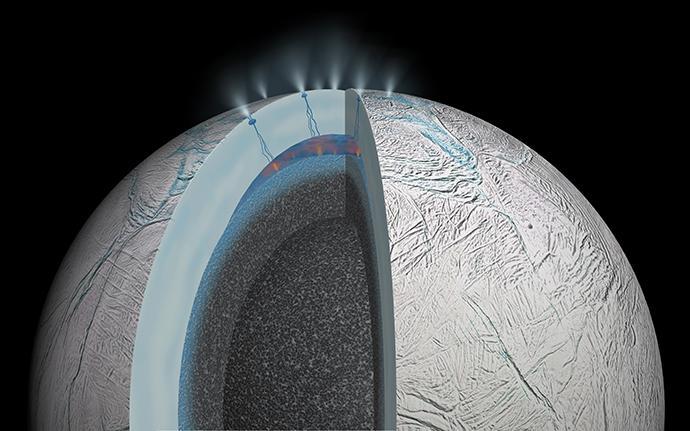Long before NASA’s Cassini spacecraft arrived at Saturn, planetary scientists had already earmarked Enceladus as one of the Solar System’s most scientifically interesting destinations; and they were not wrong, as according to a new study published in Nature Astronomy, this small icy moon appears to be producing too much methane in its ocean – a sign that could indicate microbes are feeding on vents deep down on the seafloor, say the researchers involved.
Covered with an ice shell about 30 to 40 kilometers (19 to 25 miles) thick, and only 505 kilometres (314 miles) across, Enceladus, which has a mass about 680 times less than Earth’s Moon, orbits Saturn at a distance of 238,000 kilometres (148,000 miles) between the orbits of two other moons, Mimas and Tethys.
Interest was piqued in this tiny Saturnian moon when in 2005 Cassini discovered jets of icy particles, laced with a brew of water and simple organic chemicals, gushing out into space from Enceladus’s icy exterior at approximately 400 meters per second (800 miles per hour).
The conclusion seemed clear; under its frozen surface, Enceladus was hiding a large global ocean of liquid salty water that was interacting with a rocky seafloor.
Further intrigue arose when the sampled molecules – dihydrogen, methane and carbon dioxide – suggested the presence of hydrothermal vents deep beneath Enceladus’ icy shell, not unlike the ones that dot the ocean floor here on Earth.
Stranger still, compared with the other plume ingredients, there was an excess of methane that couldn't be accounted for.
On Earth, deep-sea vents are covered in microbial ecosystems rich in methanogenic archaea; methane-producing microorganisms that are thought to be among the earliest cellular life forms to colonise our planet. Methanogens are typically found in oxygen-depleted environments such as sediments as well as in the intestinal tract of humans and animals.
Could organisms of this type be behind the excess of methane found spouting out of Enceladus?
"We wanted to know: Could Earthlike microbes that 'eat' the dihydrogen and produce methane explain the surprisingly large amount of methane detected by Cassini?" said Regis Ferriere, an associate professor in the University of Arizona Department of Ecology and Evolutionary Biology and one of the study's two lead authors.
Searching for methanogens in situ at Enceladus' seafloor would be extremely challenging and is a mission that is unlikely to happen for at least the next few decades.
So Ferriere and team looked at the next best thing; mathematical models that combined geochemistry and microbial ecology to calculate if hydrothermal production of dihydrogen would best fit Cassini's observations, and whether this production could provide enough "food" to sustain a population of methanogens.
They also looked at what effect a hypothetical microbe population would have on its environment - for example, on the escape rates of dihydrogen and methane in the plume.
Interestingly, the team’s results suggest that Cassini's data is consistent with microbial hydrothermal vent activity.
“Biological methanogenesis appears to be compatible with the data,” Ferriere says.
But, say the team, the results are also compatible with methane production by processes that don't involve life forms.
These would have to be different from processes known to occur on Earth, because the team’s calculations cannot make enough methane via known hydrothermal chemical reactions. Alternatively, it could be a combination of the two; unknown processes at work coupled with methane-producing microbial life.
“Obviously, we are not concluding that life exists in Enceladus' ocean," Ferriere says but we can't discard the 'life hypothesis' as highly improbable.
"It partly boils down to how probable we believe different hypotheses are to begin with," he said. "For example, if we deem the probability of life in Enceladus to be extremely low, then such alternative abiotic mechanisms become much more likely, even if they are very alien compared to what we know here on Earth."
One of those mechanisms could involve the chemical breakdown of primordial organic matter that may be present in Enceladus' core and that could be partially turned into dihydrogen, methane and carbon dioxide through the hydrothermal process.
This hypothesis is very plausible if it turns out that Enceladus formed through the accretion of organic-rich material supplied by comets, Ferriere explained.
With deep-dive missions to Enceladus a long-way off, the team hope to define their results with chemical data from planets outside the solar system as they become available in the coming decades.











